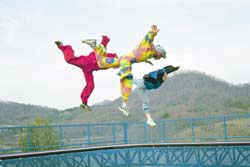
Did you ever wish you could fly? The next best thing is time spent in a "vertical wind tunnel", an experience that's like sky-diving without the need to jump out of a plane. The first vertical wind tunnel was patented in 1982 but they've only recently started to catch on as a tourist attraction.
There are both permanent and portable facilities but all of them create a single high-volume stream of air that's strong enough to support one or more people.
Some facilities are set up to lift flyers as high as 70 ft. However, beginners are kept in the 2 to 12-ft. range.
Inexperienced flyers move around a lot, while those who have developed their body position skills have much more control and some vertical wind tunnels lift flyers as high as 70 ft.
There are at least five stationary vertical wind tunnels in the U.S. open to the public in Tennessee, Nevada, Florida, California, and North Carolina. There are also at least four portable units in the U.S. Although there are currently none operating in Canada, plans are underway for three of them.
The facility, located at Pigeon Forge, Tennessee and called Flyaway Indoor Skydiving, is an indoor/fixed operation that is open to the public.
For a small fee you get three minutes of flying time. Customers wear flight suits that make flying easier by providing more lift. An instructor stands or flies at the student's side and can provide assistance when needed, so it is not difficult to stay up for the full three At the end of the three minutes, the instructor helps the customer land safely on pads around the edges of the air column (like a big donut) by guiding them when they fall off the windstream.
The Pigeon Forge facility produces an approximate airspeed (average) of 105 m.p.h. and offers a flight area of approximately 8 1/2 ft. (diameter) by 21 ft. tall.
